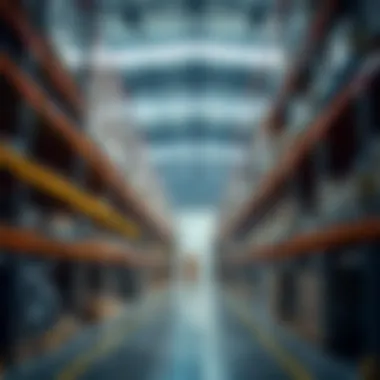Exploring Innovative Warehousing Solutions in Dubai


Intro
As the pulse of the Middle East, Dubai's logistics and warehousing sector has found itself in the limelight. Over the past few years, this vibrant city has seen a surge in demand for warehousing solutions, driven by its strategic location and the ever-growing e-commerce landscape. With global trade routes converging in the region, businesses now consider Dubai not just a hub, but a vital player in their supply chain management.
The warehousing segment in Dubai is not just about storing goods; it represents a complex web of logistics, technology, and market dynamics. Investors are keen to tap into this evolving sector, but understanding its nuances is key. This article will unravel the layers of Dubai's warehousing scene, casting light on the current trends, investment opportunities, and the factors that influence decision-making.
Throughout the following sections, we aim to provide a detailed look into the landscape of warehousing in Dubai, designed specifically for those with a vested interest—be it investors, developers, agents, or expatriates venturing into this dynamic marketplace. With careful navigation and a clear understanding of market indicators, stakeholders can make informed choices amidst rapid growth.
Overview of Warehousing in Dubai
Warehousing forms the backbone of Dubai's logistics and supply chain framework, serving as a crucial hub for trade and commerce not only in the United Arab Emirates but also across the Middle East. With the city’s strategic geographical location along trade routes, the necessity of efficient warehousing solutions cannot be overstated. This article aims to shed light on the multifaceted nature of warehousing in Dubai, providing a thorough understanding for investors and businesses alike.
Historical Context
The history of warehousing in Dubai is as vibrant as the city itself. Beginning in the 1970s, the UAE’s focus on diversifying its economy away from oil laid the groundwork for extensive development in logistics. Initially, warehouses functioned merely as storage spaces for imported goods, yet the rapid rise of trade prompted advancements in warehousing methods. The establishment of free trade zones in the late 1990s further catalyzed this growth, attracting foreign investment and providing businesses with better access to the global market.
Dubai's port facilities, such as Jebel Ali Port, one of the largest man-made harbors in the world, have been instrumental in shaping the warehousing landscape. As shipping traffic increased, so too did the need for sophisticated warehousing solutions that could accommodate diverse goods ranging from perishables to high-tech equipment. Over the decades, Dubai evolved into a logistics hub, and warehousing became a competitive field with continual investment in modern infrastructure.
Current Market Trends
Today, the warehousing market in Dubai is marked by innovation and adaptability. As e-commerce surges globally, local businesses have adapted quickly, leading to a boom in demand for logistics services. Factors driving current trends include:
- E-commerce Growth: More consumers are shopping online than ever before, prompting businesses to seek flexible warehousing solutions that can handle rapid inventory turnover.
- Technological Integration: Automation plays a pivotal role, with many warehouses implementing technologies such as robotics and artificial intelligence to enhance efficiency and reduce costs. These technologies allow for better inventory management and quicker order fulfillment, creating a seamless supply chain.
- Sustainability Initiatives: In line with global environmental standards, there's a rising emphasis on sustainability in warehousing operations. Facilities are increasingly adopting green building practices and energy-efficient systems, addressing both regulatory demands and consumer preferences.
In summary, understanding the historical context and current market trends is essential for stakeholders in Dubai’s warehousing sector. It not only frames the narrative of how we got here today but also helps investors and developers make informed decisions moving forward.
Types of Warehousing Facilities
Understanding the various types of warehousing facilities is essential for any business looking to optimize its logistics strategy in Dubai. The right choice can make a significant difference in operational efficiency, cost management, and overall service quality. As the logistics landscape continues to evolve, these facilities have become critical hubs that ensure smooth supply chains and timely service delivery. The different types of warehousing solutions not only cater to specific goods but also provide tailored services that align with the modern market demands.
General Warehousing
General warehousing serves as the backbone of the logistics sector. It provides ample storage space for a wide array of products, ranging from raw materials to finished goods. These facilities are primarily intended for the storage of dry goods and are flexible enough to accommodate various types of inventory. Accessibility is a key advantage, as these warehouses are strategically located near major transport routes, ensuring that businesses can quickly distribute their products. Investors looking for opportunities in this domain should consider the increasing demand for general warehousing, especially as more companies expand their operations in Dubai.
"In today’s fast-paced market, having a reliable general warehouse can mean the difference between a satisfied customer and a lost sale."
Cold Storage Facilities
Cold storage facilities play a crucial role in preserving perishable items that require temperature-controlled environments. These warehouses are equipped with refrigeration systems that maintain specific temperature ranges for different types of goods, such as food products and pharmaceuticals. The importance of cold storage cannot be overstated; with the rise of e-commerce and food delivery services, there is an ever-growing need for cold storage solutions. Businesses often turn to these facilities to ensure the freshness of their products, thus boosting customer trust and satisfaction. Additionally, the regulatory landscape in Dubai mandates strict compliance for food safety, making these specialized warehouses vital.
Automated Warehousing Solutions
The emergence of automated warehousing solutions marks a significant shift in the logistics industry. These facilities utilize technology, such as robotics and AI, to streamline the warehousing process. This enhancement not only increases efficiency but also minimizes human error, leading to improved accuracy in inventory management. With the rising awareness surrounding operational costs, many businesses are exploring automation as a means to reduce expenses.
An automated system can manage everything from sorting and storing to retrieving goods. That’s why savvy investors are keen to embrace this trend, seeing the potential for high returns as more companies seek to modernize their warehousing capabilities in line with global standards.
Dedicated Warehousing
Dedicated warehousing represents a tailored approach where a facility is reserved for a single client’s needs. This option is particularly beneficial for businesses that require specialized handling, consistent volume, or unique layouts. Companies often opt for dedicated warehousing to enhance their control over inventory management and logistics. The **


Strategic Locations for Warehousing
When discussing warehousing in Dubai, the significance of strategic locations cannot be overstated. Being positioned in a place where logistics and transport efficiency thrive directly affects the operational performance of warehousing facilities. Given Dubai’s status as a global trade hub, understanding location dynamics is crucial for investors, developers, and logistics companies alike. The three critical elements of strategic locations revolve around proximity to transportation hubs, access to major highways, and the impact of free zones.
Proximity to Transportation Hubs
In the realm of warehousing, transportation hubs act as the beating heart of logistics operations. Dubai is well-known for its cutting-edge airport, Dubai International Airport (DXB), which ranks among the busiest in the world. The proximity to such an airport offers warehousing facilities swift access to international shipping routes, facilitating quicker processing and delivery of goods.
When warehouses are near the airport, they benefit from reduced lead times for air freight. Similarly, Jebel Ali Port, the largest man-made port in the world, serves as another strategic asset, enabling seamless sea freight logistics. For businesses reliant on quick turnaround times, being encompassed by these transportation hubs can make or break operational efficiency. Moreover, the interconnectivity between these hubs allows for a smoother flow of goods, enhancing overall supply chain resilience.
- Reduced lead times: Close proximity accelerates import and export cycles.
- Extended market reach: Access to global markets becomes easier and more cost-effective.
- Flexibility in logistics: Easier routing options can accommodate changing demands swiftly.
Access to Major Highways
Access to major highways is yet another pivotal element impacting warehousing operations in Dubai. The city is famously crisscrossed by extensive road networks, which connect various emirates and regions. Major highways, like Sheikh Zayed Road and Emirates Road, make transporting goods between Dubai and other areas of the UAE efficient.
Warehousing facilities that sit along these routes gain several advantages:
- Cost efficiency: Transporting goods over short distances reduces fuel costs and vehicle wear.
- Time savings: Faster transit times lead to timely deliveries and satisfied customers.
- Ease of access for staff: Workforce commuting becomes manageable, boosting workforce stability and morale.
The emphasis on enhancing road infrastructure by the Dubai government further strengthens this point. Investments in road expansions and maintenance ensure the seamless movement of goods, making it easier for warehouses to thrive and flourish.
Impact of Free Zones
Another significant feature of Dubai’s warehousing landscape is the establishment of Free Zones. These zones are tailored to attract foreign investment, offering various incentives such as tax exemptions and reduced regulatory hurdles.
Warehousing facilities located in Free Zones enjoy an array of benefits:
- Customs advantages: Goods can be moved in and out without incurring customs duties.
- Regulatory flexibility: With less stringent regulations, businesses can operate more freely compared to those outside these zones.
- Attractive to investors: The favorable business climate draws in various enterprises, creating diverse economic activities.
As such, businesses that leverage Free Zones can scale more effectively and expand their market presence without the usual constraints of traditional warehousing environments.
To sum up, strategic locations for warehousing in Dubai play a pivotal role in the efficiency and productivity of logistics operations. Proximity to transportation hubs, robust access to highways, and the advantageous nature of Free Zones are key factors that influence warehousing decisions. Investors and developers are better positioned to make informed logistics strategies by understanding these dynamics.
Regulatory Framework Governing Warehousing
In the vibrant tapestry of Dubai's logistics and warehousing scene, the regulatory framework acts as a guiding compass. It ensures that operations run smoothly while adhering to standards that keep the environment safe and efficient. Regulations shape how warehousing businesses operate, influencing everything from the services offered to customer satisfaction. Recognizing these regulations is critical for investors, operators, and stakeholders as they navigate this bustling sector.
Licensing Requirements
Getting the necessary licenses is trial by fire for anyone looking to break into Dubai's warehousing market. Businesses must apply for relevant permits to operate legally. This often involves a multi-step process that includes documentation proving the purpose of the facility, architectural plans, and financial viability to ensure compliance with local laws.
The licensing process not only validates the business but brings peace of mind to clients and partners, knowing that the operation is above board. To give an idea, licenses can cover various types of warehousing setups, such as general and specialized facilities. Additionally, the emirate's Department of Economic Development has stringent criteria, which can serve as both a hurdle and a motivation for businesses striving for excellence in service and management.
Here's a snapshot of the essential licensing steps:
- Application Submission: Preparing detailed documentation and submitting applications to relevant authorities.
- Inspection: Authority officials often conduct site inspections to verify adherence to approved plans.
- Approval: Upon satisfying all regulations, businesses receive their operational license, effectively opening their doors.
Customs Regulations


Dubai's strategic location makes it a pivotal trade nexus, thus customs regulations play a vital role in warehousing. The customs framework governs how goods move in and out of warehouses, aiming to strike a balance between facilitating trade and maintaining security. By understanding customs nuances, businesses can effectively manage their inbound and outbound logistics, ensuring compliance and minimizing delays.
Warehouses that handle imported goods must adhere to specific customs compliance criteria, including:
- Documentation: Ensuring all shipments are backed by proper paperwork, including invoices and packing lists.
- Duty Payment: Clear understanding of import duties and taxes applied is essential for maintaining profitability when handling international goods.
- Storage Regulations: Different customs rules can apply depending on the types of goods stored, necessitating awareness to prevent penalties.
Adhering to these regulations not only aids in seamless operations but also builds a company’s reputation, fostering trust with clients.
Safety and Compliance Standards
Safety standards in warehousing are non-negotiable; they’re the backbone that prevents accidents and ensures compliance with local and international regulations. Each warehouse must guarantee the safety of its employees, maintaining strict adherence to Occupational Safety and Health Administration guidelines, as well as local regulations. Compliance standards often include measures for fire safety, structural integrity, and proper storage of hazardous materials.
Key safety compliance steps include:
- Regular Training: Continuous training programs for staff to keep them informed about safety protocols.
- Safety Equipment: Ensuring all personnel have access to safety gear appropriate for their tasks, from helmets to fire extinguishers.
- Routine Inspections: Regular checks to identify potential hazards in the work environment, which can prevent costly accidents.
By fostering a culture of safety, managers not only comply with legal requirements but also enhance employee morale and productivity, resulting in a robust warehouse operation.
In essence, a thorough understanding of the regulatory landscape is indispensable for anyone involved in Dubai’s warehousing sector. By navigating these turbulent waters with diligence and precision, businesses pave the way for growth and seamless logistics.
Challenges Facing Warehousing Operators
As Dubai continues to strengthen its position as a major logistics hub, the challenges faced by warehousing operators cannot be overlooked. Understanding these intricacies is vital for anyone looking to invest in this sector or even operate a warehouse. Whether you're a seasoned pro or just dipping your toes into the waters of logistics, being aware of the pressing challenges in this industry is crucial for navigating its complexities and making sound decisions.
Rising Operational Costs
One of the most pressing challenges facing warehousing operators in Dubai today is the escalation of operational costs. Over the past few years, expenses related to rent, utilities, and labor have surged significantly. The skyrocketing demand for warehouse space, coupled with limited availability, has led to inflated rental prices.
Moreover, utility costs have not remained static either. With increasing regulations around energy consumption, businesses are often forced to adopt measures that can drive up costs initially, such as eco-friendly investments. It’s essential to recognize how these rising operational costs can squeeze margins for warehouse operators, making it paramount to implement stringent cost-control measures and seek innovative pricing strategies.
- Emphasis on efficiency: Adopting automated systems.
- Negotiate leases strategically: Building good relationships with landlords can provide leverage.
- Explore alternative locations: Considering areas outside Dubai's core where rents may be more favorable can also ease budget pressures.
Supply Chain Disruptions
The volatility facing supply chains is another hurdle that warehouse operators in Dubai must grapple with. Global events, ranging from pandemics to geopolitical tensions, can send shockwaves through logistics systems, causing delays and unpredictability. The recent supply chain disruptions have highlighted the vulnerability of just-in-time inventory strategies.
A robust contingency plan is essential. Warehousing operators should diversify their supply sources to mitigate risks. Establishing robust relationships with multiple suppliers can provide a backup in case primary suppliers fail to deliver.
Future Trends in Dubai Warehousing
Dubai's warehousing sector stands at the precipice of transformation, driven by innovation, sustainability efforts, and the ever-evolving needs of the market. Understanding these trends is essential for stakeholders looking to navigate the complexities of logistics and supply chain management in this bustling emirate. The emphasis on technological advancements, eco-friendly practices, and market adaptability not only enhances the efficiency of warehousing operations but also positions Dubai as a leading global logistics hub.
Technological Innovations
In recent years, Dubai has embraced a wave of technological innovations that are reshaping the warehousing landscape. Automation technologies, such as robotics and IoT (Internet of Things), are increasingly integrated into warehousing facilities. These innovations streamline operations, minimize human error, and reduce costs. For instance, automated picking systems can facilitate faster inventory retrieval, enabling businesses to meet the growing demand for rapid delivery services.
Furthermore, utilizing AI (Artificial Intelligence) in inventory management optimizes stock levels based on real-time data analytics. This not only enhances accuracy but also improves resource allocation. As such, operators who invest in these technologies are likely to reap tangible benefits.
Sustainability Initiatives
Another significant trend in Dubai's warehousing sector is the growing focus on sustainability. As businesses become more aware of their environmental footprint, the demand for green warehousing solutions is on the rise. This encompasses a variety of strategies, from utilizing energy-efficient equipment to implementing waste reduction programs. For instance, some warehouses are now designed with solar panels, which can significantly lower energy costs. Additionally, rainwater harvesting systems are being integrated into designs, reflecting an innovative stride towards water conservation.
Sustainable practices not only comply with government regulations but also appeal to eco-conscious consumers, enhancing corporate image and driving business toward more ethical operations.


Emerging Market Needs
As the market continues to evolve, there is an increasing need for warehousing solutions that cater specifically to emerging sectors. For example, as e-commerce flourishes, operators must adapt facilities for last-mile delivery solutions that can effectively serve urban areas with high demand. This may involve smaller warehouses located closer to population centers to ensure quicker turnaround times and improved service levels.
Moreover, sectors such as pharmaceuticals and food service require specialized facilities with temperature control and strict hygiene standards. Investing in dedicated spaces that meet these unique requirements is critical for businesses aiming to maintain compliance and operational excellence.
"By anticipating future trends, businesses can avoid pitfalls and position themselves favorably in a competitive market."
In summary, staying ahead of future trends in Dubai's warehousing sector not only equips investors and businesses for growth but also aligns with the world’s move towards efficiency and sustainability. Embracing technologies, committing to green practices, and understanding market demands will play a fundamental role in shaping the logistics landscape in Dubai. Stakeholders must remain vigilant and adaptable to harness these trends effectively.
Investment Opportunities in Warehousing
Investing in warehousing has become increasingly important in Dubai, a city that serves as a crucial logistics hub in the Middle East. The rapid growth of e-commerce, coupled with the strategic positioning of Dubai between Asia, Europe, and Africa, highlights the vast potential in this sector. For investors, tapping into the warehousing market is not merely a financial decision; it’s a chance to be part of a booming logistical framework that supports global trade.
With numerous companies and industries gravitating towards Dubai, the need for efficient storage and distribution facilities continues to rise. As the city progresses towards becoming a key player in international logistics, the implications for investment opportunities are substantial.
Identifying Profitable Projects
When it comes to identifying profitable projects in warehousing, several factors come into play. Understanding the dynamics of the Dubai market is critical. Here are some pointers for investors to consider:
- Market Demand: Keeping a finger on the pulse of market needs is vital. This involves staying aware of emerging sectors, such as online retail, pharmaceuticals, and food distribution, which inherently require efficient storage solutions.
- Location Analysis: Given Dubai's geographic advantage, proximity to airports, seaports, and major highways plays a huge role in investment returns. An investor should assess areas with high demand from logistics services and ease of access.
- Facility Type: The type of warehousing facility matters. For instance, specialized cold storage facilities often yield higher returns due to the increasing demand for perishable goods. On the other hand, general warehousing may be more versatile but could face stiff competition.
- Regulatory Environment: Understanding local regulations and zoning laws is paramount. Some areas might offer incentives for new businesses, which can enhance profit margins.
“In a landscape as dynamic as Dubai, it’s essential to remain informed of all factors that may affect your investment decisions.”
- Technological Integration: Projects that incorporate automation and smart technology may offer enhanced efficiency, which can translate to better profitability. Keeping up with innovation could be a game changer.
Partnerships and Collaborations
Building successful partnerships and collaborations is often the backbone of thriving warehousing ventures. Investors should look into:
- Local Partnerships: Collaborating with local businesses can provide insights into the market that outsiders might overlook. Local partners often have established relationships with authorities and a deeper understanding of customer preferences.
- Joint Ventures: Engaging in a joint venture can spread risk and allow access to additional resources. Moreover, working alongside established firms can enhance credibility and provide a faster route to market entry.
- International Collaborations: The global nature of logistics means that looking toward international players is often beneficial. Forming alliances with global companies can unlock vast networks and expertise that would be hard to replicate independently.
- Technology Firms: Aligning with tech developers can enable warehousing projects to leverage cutting-edge technology, making them more attractive to potential customers.
Investing in warehousing in Dubai requires a keen eye for opportunities and a robust strategy to manage risks effectively. By understanding the market's nuances and forming strategic partnerships, investors can navigate this dynamic landscape successfully.
End
The conclusion serves as the anchoring point for the entire exploration of warehousing solutions in Dubai. Its importance cannot be overstated, as it synthesizes the insights gathered throughout the article and highlights why understanding this sector is crucial for various stakeholders.
Summary of Key Insights
Throughout the article, we have uncovered several essential pieces of information regarding the warehousing landscape in Dubai.
- Dynamic Growth: The warehousing market in Dubai is thriving, driven by strategic initiatives from the government and booming trade activities.
- Diverse Facility Options: From cold storage to automated solutions, the range of facilities available in Dubai supports diverse logistical needs.
- Favorable Locations: Proximity to transportation hubs and free zones enhances operational efficiency, allowing businesses to thrive in a highly competitive market.
- Regulatory Considerations: Understanding licensing requirements and customs regulations is vital for smooth operations, making compliance a priority for businesses.
These insights underscore an evolving environment where logistics and warehousing play a central role, creating opportunities for investors and businesses looking to penetrate the market.
Final Thoughts on Dubai's Warehousing Landscape
As we reflect on Dubai's warehousing landscape, it becomes clear that this sector is not only essential for local businesses but also influential on a global scale.
The blend of innovation, strategic location, and robust infrastructure makes Dubai a fertile ground for investment, particularly in logistics.
This evolution will likely lead to emerging opportunities, as businesses must adapt to changing market needs while being mindful of sustainability and technological advancements.
"In a city where time is money, efficiency in warehousing isn't just a competitive edge—it's a necessity."
In summary, navigating Dubai’s warehousing solutions requires a nuanced understanding of regulations, technological trends, and market demands. Closing insights such as these provide a clearer view of the intricate fabric that comprises warehousing in this major hub, equipping all stakeholders with the necessary tools to thrive.







